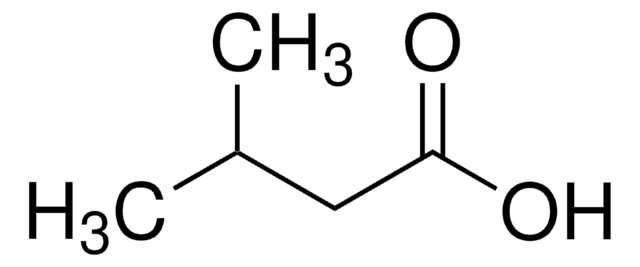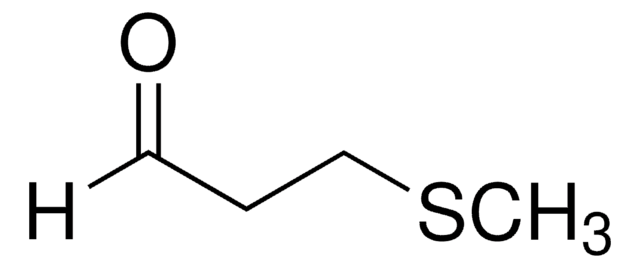Kluczowe dokumenty
W310212
Isovaleric acid
natural, ≥98%, FG
Synonim(y):
3-Methylbutanoic acid, 3-Methylbutyric acid
About This Item
Polecane produkty
klasa czystości
FG
Fragrance grade
Halal
Kosher
natural
Poziom jakości
agency
follows IFRA guidelines
zgodność regionalna
EU Regulation 1223/2009
EU Regulation 1334/2008 & 178/2002
FDA 21 CFR 172.515
ciśnienie pary
0.38 mmHg ( 20 °C)
Próba
≥98%
temp. samozapłonu
824 °F
charakterystyka ekologicznej alternatywy
Less Hazardous Chemical Syntheses
Use of Renewable Feedstocks
Learn more about the Principles of Green Chemistry.
sustainability
Greener Alternative Product
współczynnik refrakcji
n20/D 1.403 (lit.)
bp
175-177 °C (lit.)
mp
−29 °C (lit.)
gęstość
0.925 g/mL at 20 °C (lit.)
Zastosowanie
flavors and fragrances
Dokumentacja
see Safety & Documentation for available documents
alergen pokarmowy
no known allergens
alergen zapachowy
no known allergens
kategoria ekologicznej alternatywy
Organoleptyczne
cheese; fatty; acidic; sour
ciąg SMILES
CC(C)CC(O)=O
InChI
1S/C5H10O2/c1-4(2)3-5(6)7/h4H,3H2,1-2H3,(H,6,7)
Klucz InChI
GWYFCOCPABKNJV-UHFFFAOYSA-N
Szukasz podobnych produktów? Odwiedź Przewodnik dotyczący porównywania produktów
Opis ogólny
Hasło ostrzegawcze
Danger
Zwroty wskazujące rodzaj zagrożenia
Zwroty wskazujące środki ostrożności
Klasyfikacja zagrożeń
Eye Dam. 1 - Skin Corr. 1B
Kod klasy składowania
8A - Combustible corrosive hazardous materials
Klasa zagrożenia wodnego (WGK)
WGK 1
Temperatura zapłonu (°F)
176.0 °F - Pensky-Martens closed cup
Temperatura zapłonu (°C)
80 °C - Pensky-Martens closed cup
Środki ochrony indywidualnej
Faceshields, Gloves, Goggles, type ABEK (EN14387) respirator filter
Wybierz jedną z najnowszych wersji:
Masz już ten produkt?
Dokumenty związane z niedawno zakupionymi produktami zostały zamieszczone w Bibliotece dokumentów.
Klienci oglądali również te produkty
Nasz zespół naukowców ma doświadczenie we wszystkich obszarach badań, w tym w naukach przyrodniczych, materiałoznawstwie, syntezie chemicznej, chromatografii, analityce i wielu innych dziedzinach.
Skontaktuj się z zespołem ds. pomocy technicznej














